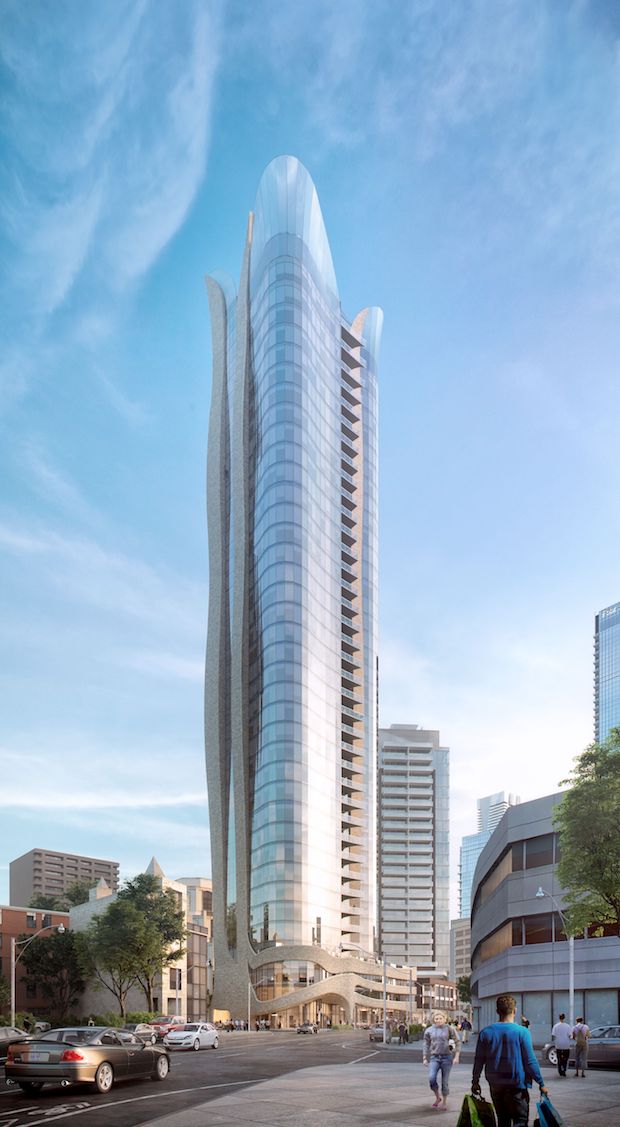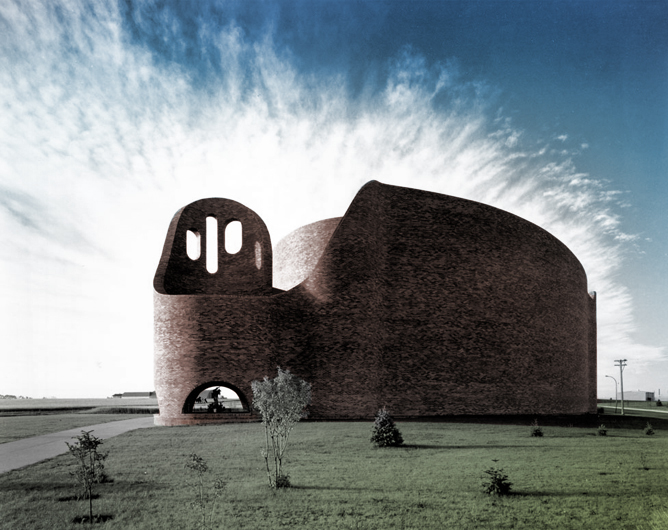On May 26, the global architectural community will turn its eyes to Venice, where the 2018 Biennale of Architecture will open, showcasing the flagship architectural installations from dozens of nations in the historic Giardini di Castello and Arsenale locations. This year, while Canada’s pavilion in the Giardini nears the end of its reconstruction, the Canadian team, led by architect Douglas Cardinal (O.C., FRAIC), will install its exhibition, titled UNCEDED: Voices of the Land, to exhibit for the course of the six-month international exhibition. Announced in November in the Year of Reconciliation, the choice of Cardinal—a Dene architect from the Anishinaabe Nation—is a natural one. After gaining national fame in the late 1960s for designing St. Mary’s Roman Catholic Church in his hometown of Red Deer, Alberta, Cardinal designed several international landmarks, including the 1989 Museum of History in Ottawa and the conceptual design for the National Museum of the American Indian in Washington, D.C., completed in 2004. Through dozens of other projects of every size and genre, Cardinal has embedded his Indigenous values in his work.
In Venice, the UNCEDED installation will showcase an ambitious array of Indigenous architecture. Co-curated by Gerald McMaster and David Fortin, the project team includes exhibiting Indigenous architects and artists Ryan Gorrie, Jake Chakasim, Wanda Dalla Costa, Ouri Scott, Matthew Hickey, Harriet Burdett-Moulton, Eladia Smoke, Tammy Eagle Bull, Chris Cornelius, Patrick Stewart, Andrea Walsh, Brian Porter, Alfred Waugh, Ray Gosselin, David Thomas, Tamarah Behay and Daniel Glenn.
Shortly after the public announcement that Cardinal would lead the 2018 Biennale, he met with Canadian Architect editor Adele Weder in Toronto for an interview about his formative experiences, architectural values and upcoming plans for Venice. The following is a condensed excerpt of their conversation.
CA: How do you see your early background as shaping you as an architect?
Cardinal: I grew up in Red Deer and went to a [Catholic residential school] convent until grade 10, and then went to a high school in Red Deer. My father was First Nations and my mother was German with a Métis mother. She was a registered nurse, very well educated; in fact, she was a supervisor at a mental hospital. When she met my father in 1926, women had very little status. Women were not legally considered to be persons. It was a very patriarchal culture. But my mother was very independent. When she met my father, she found out that how in his matrilineal culture, women are revered. My mother was the one who pushed me; she said: “You’re going to be an architect.”
CA: Can you talk about how you developed your love of architecture, and your distinctive curvilinear aesthetic—those beautiful undulations that define much of your work.
Cardinal: I was brought up in a convent, surrounded by the power of the Church. And I saw in the Church the role that architecture played: these overwhelmingly powerful architectural statements that create a sense of awe as soon as you walk into these spaces. My first building was the [St. Mary’s Roman Catholic] Church in Red Deer. I wanted to create a feeling of active loving and caring in the architecture itself—which I had found in the Baroque period, when they wanted the architecture, instead of being rigidly classic, to be more organic, more female: more like “mother church” kind of thing, to bring people back to church. It’s odd, given my background. I should really abhor the Church and the State. But guess who my main clients have been? [laughs]
CA: So does the curvilinear approach, does that directly stem from those values that you had absorbed from the Church in art history, as well as from your family background and cultural values? Is it accurate to say that it was a conflation of all these influences?
Cardinal: Yes, definitely. Of course, when I went to the University of Texas, that was reinforced too. I had a professor who felt the best way that I could develop my whole approach to architecture was to study the work of Rudolph Steiner. He would translate all of Steiner’s German texts for me. Steiner’s philosophy—that all life is sacred and children are sacred—it just seemed to be parallel to the thinking of the Indigenous people. And so at university, I decided that if I’m going to take architecture, then I should also take cultural anthropology, because I wanted to study about people, and I didn’t feel that buildings were being designed around people.
CA: Your buildings are so anthropomorphic—there’s something of the human body in them. So that’s very much a conscious part of your design approach?
Cardinal: Yes, very. I saw this in Rudolph Steiner’s work. And of course Rudolph Steiner was a major influence in where I was coming from.
CA: But you grew up in Alberta—why did you go to the University of Texas rather than to an architecture school closer to home, like the University of British Columbia?
Cardinal: Well, I attended UBC for two years in the early 50s, and finally they told me that I didn’t have the right family background for architecture—I was native. So I said: Fuck you. And I pointed my car south, and ended up in Texas. The amazing thing was that in Texas, my Canadian accent sounded like a Harvard accent to them. It was reverse discrimination! [laughs] That’s how ridiculous discrimination is.
CA: How do you expect that your background and these experiences, good and bad, will inform your UNCEDED project in Venice?
Cardinal: The whole basis of our native culture is totally different from the dominant European culture—Western so-called civilization. Western civilization is a patriarchal world view of power and control, and instills fear in people in order to control them. It’s a pyramid system, all about the few exploiting the many, with a so-called dominion over nature. It’s a binary world of good and evil, right and wrong. It objectifies everything: me, you, nature. Our Indigenous governance is in a circle, where everybody is noble, and whatever you do has to last seven generations.
CA: You have a pretty large Biennale team, with well-known architects and artists like Alfred Waugh, David Fortin, Patrick Stewart, Gerald McMaster, Wanda Dalla Costa, and a dozen more from all over Canada.
Cardinal: We have some also from the United States as well. The strength of the team is that we’re very diverse, with different perspectives, different points of view. There is no one leader.
CA: What sort of ideas are you developing to express that in Venice?
Cardinal: We’ll use audio-visual projections to show how that is expressed in architecture. Every one of the architects I talked to said: put their people first. Respect and honour the people. The other theme is to respect and honour nature.
CA: So these are the two themes, people and nature, but how will this be integrated into the architectural representation?
Cardinal: We will show the experience of how the building relates to the land visually, when you walk in and see how it is expressed in space. The only way you can express that is through audio-visual presentations, bringing visitors into the different spaces and environments that we’ll be producing. I’d like to surround people with screens—because now, they’ve got some amazing things they can do with screens, to be able to project on the walls, the floors. Some people are surprised at that: You come from an Indigenous world view and you embrace the latest technology? Of course! To me, the Indigenous perspective is the inherent values that you have to be loving and caring to all of life on the planet, including our fellow human beings.
CA: One major architectural realm where the Indigenous perspective seems to have been ignored is in government-issued housing. The mass-production of units delivered to Indigenous communities is, I think we can all agree, disconnected to the localities which it purports to serve. How can we replace it with housing designed more in accordance with the cultural values and practical needs of the local peoples?
Cardinal: I’m still working on that. The building industry is caught up in providing crap housing for people, and getting a lot of money doing it. So—we’re still working on it. Neither the housing nor the infrastructure on reserves make sense. We’re trying to create a new model, but it’s just very hard, because it’s taking on the whole bloody system. But we’re going to do it. The model will be centred on natural materials, like wood, and designed so that you can use alternative sources of energy, like solar power; and then to make sure the sewage can be treated so that you have pure water coming back to the ground.
CA: So, a more natural sewage infrastructure, using rainwater and the like.
Cardinal: Yes. You can now design sewage systems that don’t pollute rivers, by purifying it the natural way through the wetlands, and that’s what we’re doing. We’re working with a community on Kettle Point, and we were asked to plan for seven generations in a traditional way. We have to plan for the future of all the herbs, trees, birds, fish—all for seven generations. That community wants to do everything in the way of their Ojibwe culture, because they’re Anishinaabe people, and it’s a joy working with them.
CA: What are the financial means and limitations for improving the system?

The proposed 39-storey condominium tower at 100 Davenport Road in Toronto, designed by Douglas Cardinal in partnership with Scott Shields Architects for Diamante Development.
Cardinal: How we finance it is: we create a house that’s long-lasting, that will last for seven generations. You design it so that it can be manufactured in a way, such as with mass timber, so that it can be put up very fast, like four or five days.
CA: Are you confident you’ll get widespread support and collaboration from Indigenous communities for a new model of housing and infrastructure?
Cardinal: The elders, they have always supported me in the past, and even helped me with the vision for my Museum of History. When [Pierre] Trudeau commissioned me, he told me: “If you make the same commitment to this museum as you do to your people, we’ll have a great museum.”
CA: So now we have the Museum of History in Ottawa, and the National Museum of the American Indian in Washington, D.C. Do you see these as your career landmarks?
Cardinal: It’s important that I’ve put these statements in both nations’ capitals, but right now the important statement is the [Davenport] tower right here in Toronto—an Indigenous statement right at the end of Bay Street. And then the Biennale will be very important, because I think the worlds needs our values of balance, harmony, respect for the environment and for people. We don’t want to present ourselves as victims, because victims are not responsible; they say: “You did this to me!” And then they’re stuck. If you think of yourself as a victim, then you feel that people owe you one, and then you start feeling that you have to accept, that you have to take rather than give, and you don’t become a giving person.
CA: In other words, the victim mentality would be against the original Indigenous value system that you were talking about?
Cardinal: Yes, because our value system calls for people to be responsible for their lives, that you have a lot to learn from, but you have a great contribution to make.
CA: I’m wondering what you think your legacy will be. Do you feel like you’ve done what you set out to achieve?
Cardinal: No, I’ll never feel that way—until I croak, I guess. Until my last breath.





No hay comentarios:
Publicar un comentario